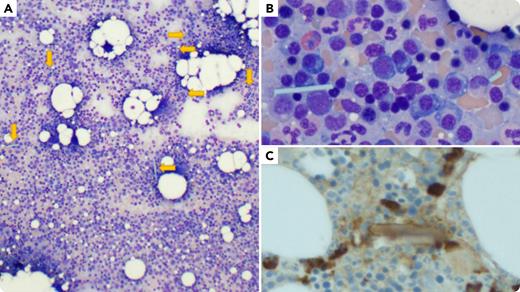A 55-year-old man with a history of gout presented with sudden proximal muscle weakness in the right arm and right leg. Neurologic evaluation included serum protein analysis by capillary electrophoresis, which indicated the presence of a IgG-λ paraprotein at 24.9 g/L. Further laboratory investigations showed no inflammation, anemia, hypercalcemia, or kidney failure. Bone marrow aspirate and biopsy were performed to investigate possible multiple myeloma. Microscopic investigation of the bone marrow smears showed the presence of 27% plasma cells (panel A: 10× objective, ×90 total magnification, May-Grünwald-Giemsa stain). Flow cytometry analysis confirmed clonality of the plasma cells, which expressed surface immunoglobulin λ, CD38, CD138, and CD56 and lacked CD45 and CD19. The patient was diagnosed with smoldering multiple myeloma; the muscle weakness was attributed to transient amyotrophic neuralgia. Remarkably, several extracellular crystals of varying lengths were observed in the smears (panel B: 100× objective, ×1250 total magnification, May-Grünwald-Giemsa stain). Immunohistochemical staining of the biopsy suggested the presence of crystalloid Ig deposits because the crystals showed peripheral staining for anti-λ (panel C: 40× objective, ×400 total magnification, λ immunostain).
Deposition of paraprotein crystals in the bone marrow has been described in only a few reports and the etiology is still unclear. Nevertheless, the presence of crystals in the bone marrow could be an indication of a plasma cell dyscrasia.


